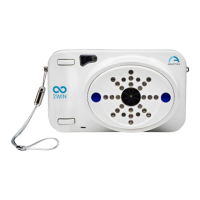73
In the images you can see the position of eye on maps, and you can easily understand
how Tropia is evidenced simply comparing position in binocular (first line) respect a cover
test (under). During cover test, the only eye the patient is using is fixating perfectly. On the
binocular vision can happens that one eye is not fixating.
Phoria is detected comparing position under cover test (position of eye covered) compared
to binocular vision eye position.
The Gaze direction is measured as the distance between the corneal reflex and the
geometric centre of the pupil.
Please consider that the corneal reflex is represented on the graph in an inverted position:
if the corneal reflex is nasal to the centre, it is represented as temporal in the diagram time.
The direction of gaze as measured by this tool is not directly related to the measurement in
cover test.
It is a graphical representation that suggests the presence of orthotropia, exo/eso tropia,
hyper/hypo tropia and stability or instability of fixation.
Range: +/-20°;
Out of range:+/- 10° refraction is not displayed (fixation error)
Resolution: 0.1°
The precision is (0.2°) on a standard eye with a corneal radius of 7.75 mm (The value is
calculated on the standard corneal radius, which is assumed to be 7.75 mm).
If a patient doesn’t focus on the central front led a warning will appear on the display:
Low fidelity message

